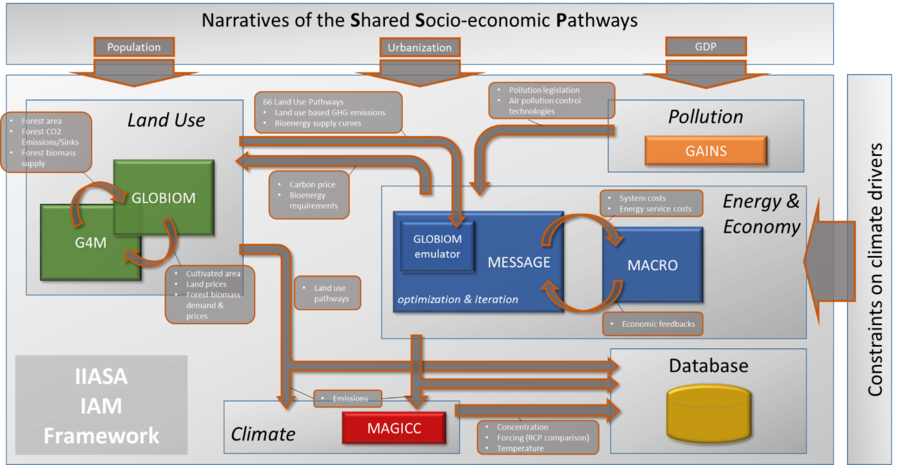Model scope and methods - MESSAGE-GLOBIOM
| Corresponding documentation | |
|---|---|
| Previous versions | |
| Model information | |
| Model link | |
| Institution | International Institute for Applied Systems Analysis (IIASA), Austria, http://data.ene.iiasa.ac.at. |
| Solution concept | General equilibrium (closed economy) |
| Solution method | Optimization |
| Anticipation | |
MESSAGEix represents the core of the IIASA IAM framework <xr id="fig:MESSAGE-GLOBIOM_iiasaiam"></xr> and its main task is to optimize the energy system so that it can satisfy specified energy demand at the lowest cost. MESSAGEix carries out this optimization in an iterative setup with MACRO, which provides estimates of the macro-economic demand response that results from energy system and services costs computed by MESSAGEix. For the six commercial end-use demand categories depicted in MESSAGEix (see Demand section of MESSAGEix-GLOBIOM), MACRO adjusts useful energy demand based on demand prices until the two models have reached equilibrium (see Macro-economy section of MESSAGEix-GLOBIOM). It thus reflects price-induced energy efficiency improvements that can occur when energy prices change. MESSAGEix can represent different energy- and climate-related policies (see Policy section of MESSAGEix-GLOBIOM).
GLOBIOM provides MESSAGEix with information on land use and its implications, like the availability and cost of bio-energy, and the availability and cost of emission mitigation in the AFOLU (Agriculture, Forestry and Land Use) sector (see Land-use of MESSAGEix-GLOBIOM). To reduce computational costs, MESSAGEix iteratively queries a GLOBIOM emulator which provides an approximation of land-use outcomes during the optimization process instead of requiring the GLOBIOM model to be rerun iteratively. Once the iteration between MESSAGEix and MACRO has converged, the resulting bioenergy demands along with corresponding carbon prices are used for a concluding analysis with the full-fledged GLOBIOM model. This ensures full consistency in the results from MESSAGEix and GLOBIOM, and also allows a more extensive set of land-use related indicators, including spatially explicit information on land use, to be reported.
Air pollution implications of the energy system are computed in MESSAGEix by applying technology-specific pollution coefficients from GAINS (see Pollutants and non-GHG forcing agents for MESSAGEix-GLOBIOM and Air pollution and health of MESSAGEix-GLOBIOM). This approach had been applied to the SSP process (Rao et al. 2017). Alternatively, GAINS can be run ex-post based on MESSAGEix-GLOBIOM scenarios to estimate air pollution emissions, concentrations and the related health impacts. This approach allows for the analysis of different air polllution policy packages (e.g., current legislation, maximum feasible reduction), including the estimation of costs for air pollution control measures. Examples for applying this way of linking MESSAGEix-GLOBIOM and GAINS can be found in McCollum et al (2018) and Grubler et al. (2018).
In general, cumulative global GHG emissions from all sectors are constrained at different levels, with equivalent pricing applied to other GHGs, to reach the desired radiative forcing levels (cf. right-hand side). <xr id="fig:MESSAGE-GLOBIOM_iiasaiam"></xr>The climate constraints are thus taken up in the coupled MESSAGEix-GLOBIOM optimization, and the resulting carbon price is fed back to the full-fledged GLOBIOM model for full consistency. Finally, the combined results for land use, energy, and industrial emissions from MESSAGEix and GLOBIOM are merged and fed into MAGICC (see Climate of MESSAGEix-GLOBIOM), a global carbon-cycle and climate model, which then provides estimates of the climate implications in terms of atmospheric concentrations, radiative forcing, and global-mean temperature increase. Importantly, climate impacts and impacts of the carbon cycle are - depending on the specific application - only partly accounted for in the IIASA IAM framework. The entire framework is linked to an online database infrastructure which allows straightforward visualisation, analysis, comparison and dissemination of results (Riahi et al., 2017).
The scientific software underlying the global MESSAGEix-GLOBIOM model is called the MESSAGEix framework, an open-source, versatile implementation of a linear optimization problem, with the option of coupling to the computable general equilibrium (CGE) model MACRO to incorporate the effect of price changes on economic activity and demand for commodities and resources. MESSAGEix is integrated with the ix modelling platform (ixmp), a "data warehouse" for version control of reference timeseries, input data and model results. ixmp provides interfaces to the scientific programming languages Python and R for efficient, scripted workflows for data processing and visualisation of results (Huppmann et al., 2019).
